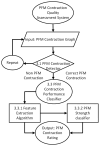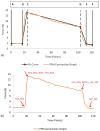Improving Pelvic Floor Muscle Training with AI: A Novel Quality Assessment System for Pelvic Floor Dysfunction
- PMID: 39517834
- PMCID: PMC11548714
- DOI: 10.3390/s24216937
Improving Pelvic Floor Muscle Training with AI: A Novel Quality Assessment System for Pelvic Floor Dysfunction
Abstract
The first line of treatment for urinary incontinence is pelvic floor muscle (PFM) training, aimed at reducing leakage episodes by strengthening these muscles. However, many women struggle with performing correct PFM contractions or have misconceptions about their contractions. To address this issue, we present a novel PFM contraction quality assessment system. This system combines a PFM contraction detector with a maximal PFM contraction performance classifier. The contraction detector first identifies whether or not a PFM contraction was performed. Then, the contraction classifier autonomously quantifies the quality of maximal PFM contractions across different features, which are also combined into an overall rating. Both algorithms are based on artificial intelligence (AI) methods. The detector relies on a convolutional neural network, while the contraction classifier uses a custom feature extractor followed by a random forest classifier to predict the strength rating based on the modified Oxford scale. The AI algorithms were trained and tested using datasets measured by vaginal dynamometry, combined in some cases with digital assessment results from expert physiotherapists. The contraction detector was trained on one dataset and then tested on two datasets measured with different dynamometers, achieving 97% accuracy on the first dataset and 100% accuracy on the second. For the contraction performance classifier, the results demonstrate that important clinical features can be extracted automatically with an acceptable error. Furthermore, the contraction classifier is able to predict the strength rating within a ±1 scale point with 97% accuracy. These results demonstrate the system's potential to enhance PFM training and rehabilitation by enabling women to monitor and improve their PFM contractions autonomously.
Keywords: artificial intelligence; pelvic floor muscle contraction; rehabilitation; urinary incontinence; vaginal dynamometer.
Conflict of interest statement
The authors declare no conflicts of interest.
Figures









Similar articles
-
The evaluation of pelvic floor muscle strength in women with pelvic floor dysfunction: A reliability and correlation study.Neurourol Urodyn. 2018 Jan;37(1):269-277. doi: 10.1002/nau.23287. Epub 2017 Apr 28. Neurourol Urodyn. 2018. PMID: 28455942
-
Is voluntary pelvic floor muscles contraction important for sexual function in women with pelvic floor disorders?Neurourol Urodyn. 2019 Sep;38(7):2001-2009. doi: 10.1002/nau.24109. Epub 2019 Jul 18. Neurourol Urodyn. 2019. PMID: 31321820
-
Pelvic floor muscle function in women with pelvic floor dysfunction: a retrospective chart review, 1992-2008.Int Urogynecol J. 2014 May;25(5):663-9. doi: 10.1007/s00192-013-2277-6. Epub 2013 Dec 12. Int Urogynecol J. 2014. PMID: 24337586
-
Quantification of pelvic floor muscle strength in female urinary incontinence: A systematic review and comparison of contemporary methodologies.Neurourol Urodyn. 2018 Jan;37(1):33-45. doi: 10.1002/nau.23285. Epub 2017 May 4. Neurourol Urodyn. 2018. PMID: 28471486
-
Determining the optimal pelvic floor muscle training regimen for women with stress urinary incontinence.Neurourol Urodyn. 2011 Jun;30(5):746-53. doi: 10.1002/nau.21104. Neurourol Urodyn. 2011. PMID: 21661024 Review.
References
-
- Rogers R.G., Pauls R.N., Thakar R., Morin M., Kuhn A., Petri E., Fatton B., Whitmore K., Kingsberg S.A., Lee J. An International Urogynecological Association (IUGA)/International Continence Society (ICS) joint report on the terminology for female pelvic floor dysfunction. Neurourol. Urodyn. 2010;21:5–26. - PubMed
-
- Booth J., Cacciari L., Campbell P., Dumoulin C., Hagen S., Homsi J., Morin M., Marked S., Nahon I., Pang R., et al. Incontinence. 7th ed. Volume 1 International Continence Society; Bristol, UK: 2023. Conservative management of UI and POP in adults including neurological patients.
MeSH terms
LinkOut - more resources
Full Text Sources

